
Concept explainers
Give IUPAC names for the following compounds:
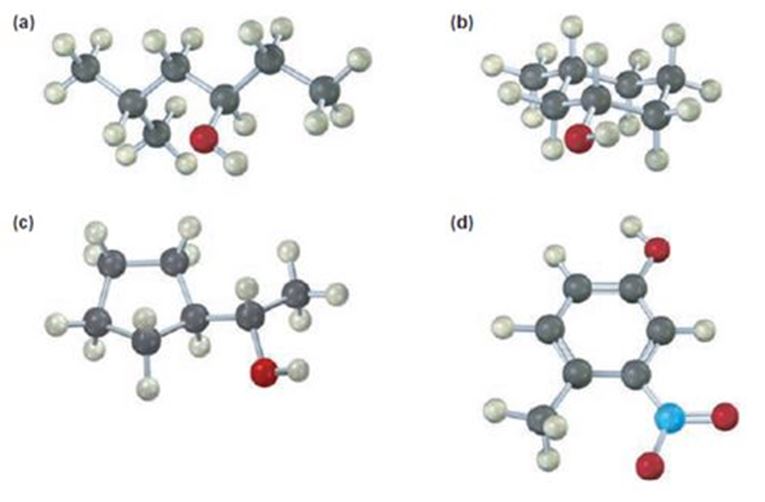
a)
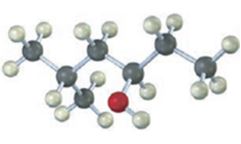
Interpretation:
To give the IUPAC name of the compound given.
Concept introduction:
Alcohols are named as derivatives of the parent alkane using the suffix–ol. The longest carbon chain containing the hydroxyl group is chosen and the parent name is derived by replacing the ending–e with–ol. The akane chain is numbered beginning at the end nearer to the hydroxyl group. The substituents are numbered according to their position on the chain. The name is written listing the substituents in the alphabetical order and indicating the position to which –OH is bonded.
If the compound is chiral then there can be two types of arrangements of the four groups attached to the chiral carbon, R and S. The four groups are arranged in the order of priority as 1,2,3 and 4 following sequence rules. The molecule is viewed by orienting the group of lowest priority (4) points away from the observer. If the arrangement of highest to second highest to third highest is clockwise the R configuration is assigned. If the arrangement is anticlockwise then S configurationis assigned.
To give:
The IUPAC name of the compound given.
Answer to Problem 20VC
The compound given is
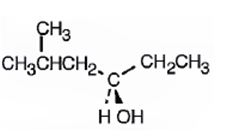
Its IUPAC name is (R) - 5 methylhexan-3-ol.
Explanation of Solution
The name of the compound indicates the presence of a six carbon straight chain with –OH on C3 and a methyl group on C5. Further the molecule is chiral. The groups –OH (highest ranking), -CH2CH(CH3)2(second highest ranking) and -CH2CH3(third highest ranking) are arranged around the chiral carbon in clockwise arrangement. Hence R configuration is assigned.
The compound given is

Its IUPAC name is (R) - 5 methylhexan-3-ol.
b)
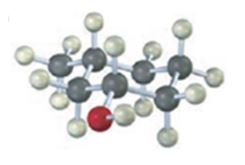
Interpretation:
To give the IUPAC name of the compound given.
Concept introduction:
In naming cyclic alcohols the parent name is derived from the cycloalkene ring by replacing–e of the cycloalkene with–ol. The ring is numbered from the carbon with –OH in such a way that lowest number possible is given to the carbons with substituents.
A cis 1,3-disubstituted cycloalkane has the two substituent groups in a diequatorial arrangement.
To give:
The IUPAC name of the compound given.
Answer to Problem 20VC
The compound given is
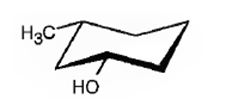
Its IUPAC name is cis-3-methylcyclohexanol.
Explanation of Solution
The structure shows that the compound contains a cyclohexane ring with a –OH and methyl groups in diequatorial positions on C1 and C3. Hence it is a cis-isomer.
The compound given is

Its IUPAC name is cis-3-methylcyclohexanol.
c)
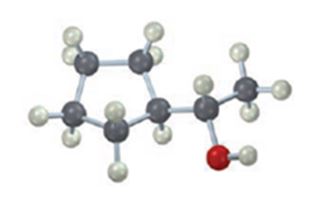
Interpretation:
To give the IUPAC name of the compound given.
Concept introduction:
Alcohols are named as derivatives of the parent alkane using the suffix–ol. The longest carbon chain containing the hydroxyl group is chosen and the parent name is derived by replacing the ending–e with–ol. He akane chain is numbered beginning at the end nearer to the hydroxyl group. The substituents are numbered according to their position on the chain. The name is written listing the substituents in the alphabetical order and indicating the position to which –OH is bonded.
If the compound is chiral then there can be two types of arrangements of the four groups attached to the chiral carbon, R and S. The four groups are arranged in the order of priority as 1,2,3 and 4 following sequence rules. The molecule is viewed by orienting the group of lowest priority (4) points away from the observer. If the arrangement of highest to second highest to third highest is clockwise the R configuration is assigned. If the arrangement is anticlockwise then S configurationis assigned.
To give:
The IUPAC name of the compound given.
Answer to Problem 20VC
The compound given is
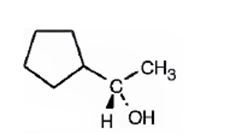
Its IUPAC name is (S)-1-cyclopentylethanol.
Explanation of Solution
The structure shows that the compound contains a two carbon straight chain with –OH and a cyclopentyl groups on C1.
The four groups, -OH(Highest priority), Cyclopentyl (second highest priority), methyl (third highest priority) attached to C1 are arranged anticlockwise when viewed away from hydrogen (fourth priority). Hence S configuration is assigned.
The compound given is

Its IUPAC name is (S)-1-cyclopentylethanol.
d)
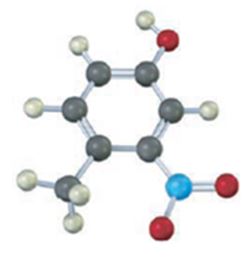
Interpretation:
To give the IUPAC name of the compound given.
Concept introduction:
Hydroxybenzenes are named as derivatives of phenol. If the ring contains other substituent also the ring is numbered from the carbon with –OH in such a way that lowest number possible is given to the carbon with the substituent. While writing the name the substituents are arranged in the alphabetical order.
To give:
The IUPAC name of the compound given.
Answer to Problem 20VC
The compound given is.
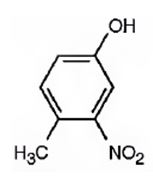
Its IUPAC name is 4-methyl-3-nitrophenol.
Explanation of Solution
The structure of the compound shows a benzene ring with –OH on C1, a nitro group on C3 and a methyl group on C4.
The compound given is.

Its IUPAC name is 4-methyl-3-nitrophenol.
Want to see more full solutions like this?
Chapter 17 Solutions
OWLv2 with Student Solutions Manual eBook, 4 terms (24 months) Printed Access Card for McMurry's Organic Chemistry, 9th
- Using wedge-and-dash bonds, modify the bonds on the chiral carbon in the molecule below so the molecule has R stereochemical configuration. NH H Br X टेarrow_forwardProvide photos of models of the following molecules. (Include a key for identification of the atoms) 1,2-dichloropropane 2,3,3-trimethylhexane 2-bromo-3-methybutanearrow_forwardPlease draw the structure in the box that is consistent with all the spectral data and alphabetically label all of the equivalent protons in the structure (Ha, Hb, Hc....) in order to assign all the proton NMR peaks. The integrations are computer generated and approximate the number of equivalent protons. Molecular formula: C13H1802 14 13 12 11 10 11 (ppm) Structure with assigned H peaks 2.08 3.13arrow_forward
- A 0.10 M solution of acetic acid (CH3COOH, Ka = 1.8 x 10^-5) is titrated with a 0.0250 M solution of magnesium hydroxide (Mg(OH)2). If 10.0 mL of the acid solution is titrated with 10.0 mL of the base solution, what is the pH of the resulting solution?arrow_forwardFirefly luciferin exhibits three rings. Identify which of the rings are aromatic. Identify which lone pairs are involved in establishing aromaticity. The lone pairs are labeled A-D below.arrow_forwardA 0.10 M solution of acetic acid (CH3COOH, Ka = 1.8 x 10^-5) is titrated with a 0.0250 M solution of magnesium hydroxide (Mg(OH)2). If 10.0 mL of the acid solution is titrated with 10.0 mL of the base solution, what is the pH of the resulting solution?arrow_forward
- Given a complex reaction with rate equation v = k1[A] + k2[A]2, what is the overall reaction order?arrow_forwardPlease draw the structure in the box that is consistent with all the spectral data and alphabetically label all of the equivalent protons in the structure (Ha, Hb, Hc....) in order to assign all the proton NMR peaks. The integrations are computer generated and approximate the number of equivalent protons. Molecular formula: C13H1802 14 13 12 11 10 11 (ppm) Structure with assigned H peaks 2.08 3.13arrow_forwardCHEMICAL KINETICS. One of the approximation methods for solving the rate equation is the steady-state approximation method. Explain what it consists of.arrow_forward
- CHEMICAL KINETICS. One of the approximation methods for solving the rate equation is the limiting or determining step approximation method. Explain what it consists of.arrow_forwardCHEMICAL KINETICS. Indicate the approximation methods for solving the rate equation.arrow_forwardTRANSMITTANCE เบบ Please identify the one structure below that is consistent with the 'H NMR and IR spectra shown and draw its complete structure in the box below with the protons alphabetically labeled as shown in the NMR spectrum and label the IR bands, including sp³C-H and sp2C-H stretch, indicated by the arrows. D 4000 OH LOH H₂C CH3 OH H₂C OCH3 CH3 OH 3000 2000 1500 HAVENUMBERI-11 1000 LOCH3 Draw your structure below and label its equivalent protons according to the peak labeling that is used in the NMR spectrum in order to assign the peaks. Integrals indicate number of equivalent protons. Splitting patterns are: s=singlet, d=doublet, m-multiplet 8 3Hb s m 1Hd s 3Hf m 2Hcd 2Had 1He 鄙视 m 7 7 6 5 4 3 22 500 T 1 0arrow_forward

 General, Organic, and Biological ChemistryChemistryISBN:9781285853918Author:H. Stephen StokerPublisher:Cengage Learning
General, Organic, and Biological ChemistryChemistryISBN:9781285853918Author:H. Stephen StokerPublisher:Cengage Learning Organic And Biological ChemistryChemistryISBN:9781305081079Author:STOKER, H. Stephen (howard Stephen)Publisher:Cengage Learning,
Organic And Biological ChemistryChemistryISBN:9781305081079Author:STOKER, H. Stephen (howard Stephen)Publisher:Cengage Learning, Chemistry for Today: General, Organic, and Bioche...ChemistryISBN:9781305960060Author:Spencer L. Seager, Michael R. Slabaugh, Maren S. HansenPublisher:Cengage Learning
Chemistry for Today: General, Organic, and Bioche...ChemistryISBN:9781305960060Author:Spencer L. Seager, Michael R. Slabaugh, Maren S. HansenPublisher:Cengage Learning Organic ChemistryChemistryISBN:9781305580350Author:William H. Brown, Brent L. Iverson, Eric Anslyn, Christopher S. FootePublisher:Cengage Learning
Organic ChemistryChemistryISBN:9781305580350Author:William H. Brown, Brent L. Iverson, Eric Anslyn, Christopher S. FootePublisher:Cengage Learning




